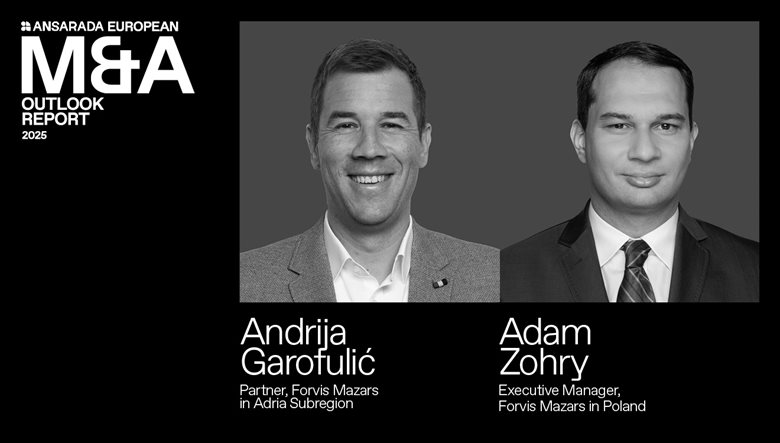Forvis Mazards Partner and Executive Manager: Central and Eastern Europe poised for M&A surge as PE funds target succession opportunities
Andrija and Adam explore Central and Eastern Europe M&A and private equity in 2025.
By AnsaradaWed Aug 13 2025Mergers and acquisitions, Industry news and trends, Innovation

In this excerpt from our 2025 European M&A Outlook Report, which features insights from 12 leading European dealmakers, Andrija Garofulić, Partner at Forvis Mazars in Adria Subregion and Adam Zohry, Executive Manager at Forvis Mazars in Poland, explore the Central and Eastern Europe (CEE) M&A and private equity (PE) landscape for the year ahead.
Global M&A activity in 2024 was on the rise – certainly in value if not volume terms after a disappointing 2023 – do you expect more activity and how do you view the CEE M&A market for the next 18 months and beyond?
Andrija Garofulić (AG): The dealmaking environment in 2023, and a good part of 2024, was certainly challenging. Political instability, a tough macroeconomic climate and stubbornly high interest rates have all caused frequent delays to dealmaking. While there is plenty of money on the table, it has been difficult to allocate. As we look ahead to 2025, there remain numerous open questions surrounding the direction of geopolitics and monetary policies.
Yet, despite these ongoing challenges, I would say we are more optimistic than 12 months ago. One reason for this optimism is the level of dry powder in the market, which is creating opportunities across sectors such as technology, media and telecommunication (TMT), consumer, healthcare and renewable energy. We are also seeing opportunities arise due to succession planning and transfer of ownership.
Adam Zohry (AZ): Taking a CEE region-wide view, nearshoring is becoming a popular route for investors. This trend is playing out across Central and Eastern Europe amid an increasingly unstable global geopolitical climate. Ongoing instability caused by the Covid-19 pandemic, the war in Ukraine and geopolitical tensions with China have exposed the need for resilient, local supply chains. We are witnessing an increased interest from funds (notably from Western Europe and the USA) looking to acquire add-on businesses within the CEE region.
With an abundance of dry powder, a willingness to deploy and a desire to get back to the dealmaking table after a lacklustre 2023, what do you think will happen to the level of PE activity across the CEE region between now and the end of 2025?
AG: There is definitely strong momentum in the market, which I expect to continue over the next few years. There are plenty of companies on the market, yet an insufficient level of strategic buyers to acquire them all. PE funds have the necessary and available funds to act as a catalyst within the market, as well as the ability to buy, consolidate, professionalise and grow these companies. I expect they will have a successful couple of years in front of them.
When answering this question, it is important to note the difference between developed PE markets and the developing markets in the region in which we operate. In the CEE, especially in the less developed parts, the PE market is supported by regional funds such as the European Investment Fund and the EBRD. We expect this support to generate healthy PE deal activity in 2025.
AZ: Succession planning is another major opportunity for PE funds. Within the CEE region, capitalism is relatively new – it is only 35 years since the fall of communism. In markets such as the UK, France and Germany, it is estimated that between 20 – 30% of companies are in the hands of the first generation. In the CEE markets, this figure can be up to 80%, making it prime timing for succession processes. Consequently, there will be a strong wave of succession opportunities for M&A, both for strategics and financial investors.
There are also challenges facing the PE industry. Due to complexities within the market, funds are not able to exit all of the platform investments that they have made historically. This is demanding for PE from two aspects.
Firstly, they do not have the track record to go to investors with success stories, making it more difficult to raise new funds. And secondly, it is difficult to invest from a new fund while you still have some operational assets that need taking care of in an existing fund. For this reason, continuation funds – whereby assets from historical funds are sold or transferred to newly established funds operated by the same fund manager – have become a much-discussed topic.
How do the challenges facing PE firms in 2025 differ from those facing corporates?
AG: As a professional investor, PE firms have a limited investment period. The majority have a five-year timeframe in which they need to buy an asset, build or grow that asset and find a suitable buyer to exit. They need to exit more or less three times what they initially invested. While obliged to align with corporate strategies, corporates do not face the same pressure. Quite often they have more time to deploy capital and grow the businesses.
What this means is that PE are more selective and once they acquire a company they need to be very focused on the job to be done. They still need to deliver even at times where the efficiency of capital is below expectations and the external factors are not on their side. All of the risks that strategic players are facing - market exposure, market risk, availability of people, external risk, monetary policy – also impact the PE market. The only difference is that PE has a defined period in which they need to grow and exit the company.
AZ: Generally speaking, if a small to medium-size enterprise (SME) owner has a choice between being acquired by a PE fund or a strategic investor, they tend to feel that they have more in common with the strategic investor. They speak the same language and, as is often the case, operate in the same sector. For this reason, the pressure is on PE funds to specialise in specific sectors across the CEE market. They also need to adapt their business culture mindset and behaviour to the specificity of CEE SME entrepreneurs. This has not always been easy in the past, but hopefully we are increasingly seeing this change across our CEE small and mid-cap markets.


